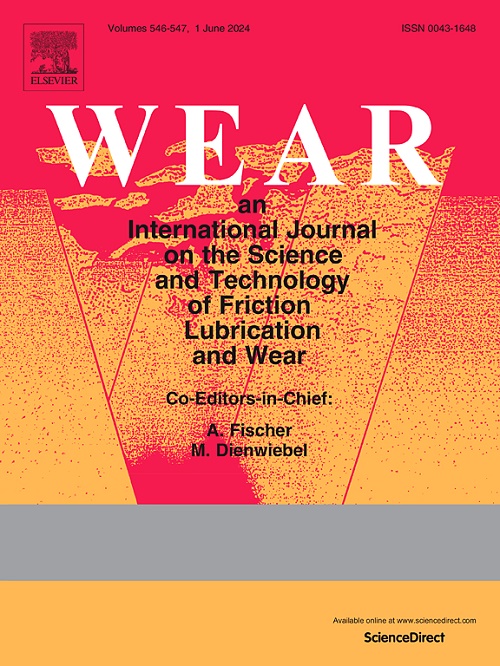Impact of tunneling parameters on disc cutter wear during rock breaking in transient conditions
IF 5.3
1区 工程技术
Q1 ENGINEERING, MECHANICAL
引用次数: 0
Abstract
The assessment of disc cutter wear in subway shield construction beneath operational airports is a critical endeavor for evaluating the structural integrity of shield machines. This study delved into the linear tunnel project linking Station T1 to T3 within the Baiyun airport, focusing on the intricate relationship between tunneling parameters during rock-machine interactions and the impact of disc cutter installation radius on wear amount. In addition, dynamic impact transient rock-breaking tests of shield disc cutters were performed under the coupled thermo-hydro-mechanical triaxial conditions to ensure the validity of the relationship between mass-point velocity and the transient rock-breaking behavior of the disc cutter. The analysis revealed that when the shield thrust was between 17000 kN and 21000 kN, the total thrust of the shield had a significant effect on the advancement speed and cutterhead torque. Notably, the wear amount of the cutter increased approximately linearly with the installation radius, while the wear of the gauge cutter was also affected by the inclination angle. Furthermore, the study uncovered a linear correlation between the cutting length of the disc cutter and the magnitude of wear. Within a cutting length range between 440 km and 2276 km, the disc cutter's installation position had minimal impact on the wear coefficient. Simultaneously, this study employed the mass-point velocity to simulate the thrust and rolling forces in the equivalent shield tunneling processes. The findings underscored a positive correlation between disc cutter wear and shield advancement speed, cutterhead rpm, and mass-point velocity. When the mass-point velocity of the shield reached the maximum value of 0.666 m/s, the wear of the shield disc cutter also reached the maximum value of 27.5 mm, providing the quantitative reference for evaluating the influences of shield tunneling parameters on the cutter wear under transient impact rock breaking conditions.
掘进参数对瞬态条件下破岩过程中圆盘铣刀磨损的影响
在运营中的机场地下进行地铁盾构施工时,对圆盘刀磨损的评估是评价盾构机结构完整性的一项重要工作。本研究深入探讨了连接白云机场 T1 站和 T3 站的直线隧道工程,重点研究了岩机相互作用过程中隧道参数之间的复杂关系,以及圆盘刀安装半径对磨损量的影响。此外,还在热-水-机械三轴耦合条件下进行了盾构圆盘刀动态冲击瞬态破岩试验,以确保质点速度与圆盘刀瞬态破岩行为之间关系的有效性。分析结果表明,当盾构推力在 17000 kN 至 21000 kN 之间时,盾构总推力对推进速度和刀盘扭矩有显著影响。值得注意的是,刀盘的磨损量与安装半径呈近似线性增长,而轨距刀盘的磨损也受倾斜角的影响。此外,研究还发现圆盘铣挖机的铣挖长度与磨损程度之间存在线性关系。在 440 千米到 2276 千米的切割长度范围内,圆盘铣挖机的安装位置对磨损系数的影响微乎其微。同时,这项研究还利用质点速度模拟了等效盾构掘进过程中的推力和滚动力。研究结果表明,圆盘刀磨损与盾构推进速度、刀盘转速和质点速度之间存在正相关关系。当盾构的质点速度达到最大值 0.666 m/s 时,盾构圆盘刀盘的磨损也达到最大值 27.5 mm,为评估瞬态冲击破岩条件下盾构掘进参数对刀盘磨损的影响提供了定量参考。
本文章由计算机程序翻译,如有差异,请以英文原文为准。
求助全文
约1分钟内获得全文
求助全文
来源期刊

Wear
工程技术-材料科学:综合
CiteScore
8.80
自引率
8.00%
发文量
280
审稿时长
47 days
期刊介绍:
Wear journal is dedicated to the advancement of basic and applied knowledge concerning the nature of wear of materials. Broadly, topics of interest range from development of fundamental understanding of the mechanisms of wear to innovative solutions to practical engineering problems. Authors of experimental studies are expected to comment on the repeatability of the data, and whenever possible, conduct multiple measurements under similar testing conditions. Further, Wear embraces the highest standards of professional ethics, and the detection of matching content, either in written or graphical form, from other publications by the current authors or by others, may result in rejection.
 求助内容:
求助内容: 应助结果提醒方式:
应助结果提醒方式:


